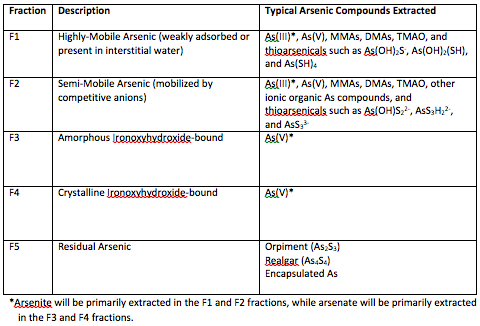Sep 1, 2015
 It has become increasingly common for risk assessment and treatability studies to require arsenic speciation data to determine the potential mobility of this toxic contaminant at varying sites.
It has become increasingly common for risk assessment and treatability studies to require arsenic speciation data to determine the potential mobility of this toxic contaminant at varying sites.
Looking at arsenite [As(III)] and arsenate [As(V)] values can be helpful for these studies; however, this approach can only provide a snapshot of how much arsenic is readily leachable at any given time. In situ, the conditions in soil and sediment samples can change over time depending on many factors, including the amount of rainfall, contaminant plume movement, and the hydrogeology at each individual site. Arsenic trapped in various mineral phases can be mobilized under varying site conditions, and even the treatment technologies used to remediate a site can affect the chemistry of the targeted environment and the subsequent arsenic lability.
At Brooks Rand Labs (BRL), we have a proprietary procedure for the selective sequential extraction of groups of arsenic species in soluble, adsorbed, and precipitated forms of arsenic compounds in soils, sediments, and similar solid matrices using a series of solutions with an increasing ability to solubilize and extract the solid-phase arsenic. Rather than identify specific arsenic species, the arsenic is fractionated in accordance with its interaction with iron oxyhydroxides, manganese oxyhydroxides, aluminum oxides, and other substrate components. The applied extraction solutions are designed to target the different substrate components and stabilize the respective arsenic species within each of the defined fractions below. The typical arsenic compounds listed for each fraction are only representative of how the method can perform and will fluctuate with different sites and conditions.

The BRL arsenic sequential extraction method accompanied by analysis of each fraction for total arsenic and other elements can be a powerful tool to help predict how much arsenic will be mobilized under different conditions. This type of information can be of enormous value for modeling, risk assessment, and design/engineering of treatment technologies.
If you would like more information about the selective sequential extraction procedure for arsenic speciation and whether it would be appropriate for your project, please contact us.
Aug 14, 2015
 Human exposure to natural and synthetic contaminants has recently come to the forefront of public concern with frequent stories in the media about the potential harm from metals in our environment. Fish consumption, vaccines, contaminated food products, and poorly regulated supplements are all potential threats to human health. Assessing human biomonitoring samples can be quite challenging because every sample has its own unique chemistry depending on lifestyle and genetics, as well as differences from food and supplement intake. Brooks Rand Labs can support the elemental and molecular quantitation of metals and halogenated compounds for every distinctive sample submitted. For more than a decade, Brooks Rand Labs has provided analytical method development and specialized analysis of ions, small molecules, amino acids, proteins, and other more complex molecular forms in a variety of human tissues and fluids, including blood, urine, organ tissue, hair, and teeth. If you would like further information or a quotation for your next project, please contact us.
Human exposure to natural and synthetic contaminants has recently come to the forefront of public concern with frequent stories in the media about the potential harm from metals in our environment. Fish consumption, vaccines, contaminated food products, and poorly regulated supplements are all potential threats to human health. Assessing human biomonitoring samples can be quite challenging because every sample has its own unique chemistry depending on lifestyle and genetics, as well as differences from food and supplement intake. Brooks Rand Labs can support the elemental and molecular quantitation of metals and halogenated compounds for every distinctive sample submitted. For more than a decade, Brooks Rand Labs has provided analytical method development and specialized analysis of ions, small molecules, amino acids, proteins, and other more complex molecular forms in a variety of human tissues and fluids, including blood, urine, organ tissue, hair, and teeth. If you would like further information or a quotation for your next project, please contact us.
Aug 14, 2015
 Did you miss out on the International Conference on Mercury as a Global Pollutant (ICMGP) this year (held in South Korea in June)? Here’s a chance to get a rundown of conference highlights! BRL’s Annie Carter will be speaking at the September 9th meeting of the Delta Tributaries Mercury Council (DTMC) between 12:45 – 1:10 pm. And, you don’t have to travel to Sacramento to participate in DTMC meetings; they are available in real-time via WebEx. While at the ICMGP, Ms. Carter discussed distillation techniques for methylmercury analysis and, of course, attended many sessions emphasizing the latest developments in the world of mercury research.
Did you miss out on the International Conference on Mercury as a Global Pollutant (ICMGP) this year (held in South Korea in June)? Here’s a chance to get a rundown of conference highlights! BRL’s Annie Carter will be speaking at the September 9th meeting of the Delta Tributaries Mercury Council (DTMC) between 12:45 – 1:10 pm. And, you don’t have to travel to Sacramento to participate in DTMC meetings; they are available in real-time via WebEx. While at the ICMGP, Ms. Carter discussed distillation techniques for methylmercury analysis and, of course, attended many sessions emphasizing the latest developments in the world of mercury research.
The DTMC brings together a wide array of participants who manage and monitor Northern California’s waterways. To join the DTMC mailing list, please contact Stephen McCord (McCord Environmental, Inc.) at sam@mccenv.com or sign-up online.
Aug 14, 2015
 For large sample collection tubing and equipment orders, BRL requests at least three weeks’ notice in order to ensure all equipment is certified clean for low-level metals analysis. We take great pride in ensuring equipment meets your data quality objectives by taking several days (to weeks) for cleaning, testing, and quality assurance review.
For large sample collection tubing and equipment orders, BRL requests at least three weeks’ notice in order to ensure all equipment is certified clean for low-level metals analysis. We take great pride in ensuring equipment meets your data quality objectives by taking several days (to weeks) for cleaning, testing, and quality assurance review.
This summer, BRL pulled off an extraordinary feat that will go down as legendary in our history. Over a period of less than 6 weeks, over 36,000 feet of sample collection tubing were acid-cleaned and certified clean for trace metals use. This amount is far greater than the height of Mt. Everest (a mere 29,029 feet).
BRL management wishes to thank all of the employees who contributed to this achievement, especially those who worked long hours wearing respirators over acid vats. We also want to thank our clients who pushed us to achieve what only few could hope to accomplish in a lifetime.
Jul 15, 2015
 In 1983, the first inductively coupled plasma-mass spectrometer (ICP-MS) was introduced, revolutionizing metals analysis. The new technology allowed for metals to be analyzed with unprecedented productivity and the ability to attain ultra-low detection limits with excellent precision and accuracy. While there are many benefits with ICP-MS metals analysis, there are also drawbacks inherent to the methodology and many different types of interferences, such as isobaric, polyatomic, and double-charged, ions that can result in skewed data. Employing various interference reduction technologies, such as collision cell and reaction cell, work great for many of these interferences; however, the different mechanisms utilized by each method have uniquely inherent limitations. The more recent technology employed by the Agilent 8800 ICP Triple Quad (ICP-QQQ) utilizes non-reactive gases such as helium as well as reactive gases like ammonia, oxygen, and hydrogen. The unique configuration of this instrument greatly reduces variability, ensuring delivering greater accuracy and more consistent results. Unless you know exactly what all the constituents are in your sample, you cannot predict what kind of interference you may have and the ability to run an instrument in different modes and look for matching results between the modes increases the probability of a successful project while lowering the overall cost.
In 1983, the first inductively coupled plasma-mass spectrometer (ICP-MS) was introduced, revolutionizing metals analysis. The new technology allowed for metals to be analyzed with unprecedented productivity and the ability to attain ultra-low detection limits with excellent precision and accuracy. While there are many benefits with ICP-MS metals analysis, there are also drawbacks inherent to the methodology and many different types of interferences, such as isobaric, polyatomic, and double-charged, ions that can result in skewed data. Employing various interference reduction technologies, such as collision cell and reaction cell, work great for many of these interferences; however, the different mechanisms utilized by each method have uniquely inherent limitations. The more recent technology employed by the Agilent 8800 ICP Triple Quad (ICP-QQQ) utilizes non-reactive gases such as helium as well as reactive gases like ammonia, oxygen, and hydrogen. The unique configuration of this instrument greatly reduces variability, ensuring delivering greater accuracy and more consistent results. Unless you know exactly what all the constituents are in your sample, you cannot predict what kind of interference you may have and the ability to run an instrument in different modes and look for matching results between the modes increases the probability of a successful project while lowering the overall cost.
If you would like to learn more about the topic of avoiding analytical interferences, you may view a presentation given by BRL’s Technical Director, Dr. Hakan Gürleyük, at the 2015 Department of Defense Environmental Monitoring and Data Quality meeting, Analysis for Arsenic and Hexavalent Chromium: How to avoid false positives and increase data quality. For more specific information about how the various options for interference reduction technology can support your project or for a quotation, feel free to contact us.
Jul 15, 2015
 Technically, rare earth elements (Ce, Dy, Er, Eu, Gd, Ho, La, Lu, Nd, Pr, Pm, Sm, Sc, Tb, Tm, Yb, and Y) are not truly rare (with a few exceptions), and they may be found liberally dispersed within the Earth’s crust. Most of the rare earth elements (REE) are mined in China (95%), but in response to a recent increase in demand for REEs used in manufacturing of modern technology, former and new mining facilities have been placed in production throughout North America.
Technically, rare earth elements (Ce, Dy, Er, Eu, Gd, Ho, La, Lu, Nd, Pr, Pm, Sm, Sc, Tb, Tm, Yb, and Y) are not truly rare (with a few exceptions), and they may be found liberally dispersed within the Earth’s crust. Most of the rare earth elements (REE) are mined in China (95%), but in response to a recent increase in demand for REEs used in manufacturing of modern technology, former and new mining facilities have been placed in production throughout North America.
In the spirit of being enthusiastically fearless for taking on unusual or unique analytical challenges, BRL routinely provides REE analyses at ppb concentrations in soils and vegetation for the research of REE phytotoxicity and uptake in soils. In the recent journal article Uptake and Effects of Six Rare Earth Elements (REEs) on Selected Native and Crop Species Growing in Contaminated Soils(Carpenter et. al., PLoS ONE (2015) 10,6), the application of the REE data provided by BRL was examined, inciting additional research into the phytotoxicity and accumulation of REE in our environment. In this study soils, specific native wild plants, and crop plants were analyzed for Pr, Nd, Sm, Tb, Dy, and Er. Differences in above ground and below ground plant mass were quantified, demonstrating marked differences in growth patterns of crop plants verses wild native plant species.
Two other similar studies were also recently published using REE analytical data from BRL: Cerium Chloride Heptahydrate (CeCl3·7H2O) Induces Muscle Paralysis in the Generalist Herbivore, Melanoplus sanguinipes (Fabricius), fed Contaminated Plant Tissues (Allison et. al., Chemosphere 120 (2015) 674-679) and Rare Earth Elements (REEs): Effects on Germination and Growth of Selected Crop and Native Plant Species (Thomas et. al., Chemosphere 96 (2014) 57-66). The overall conclusion from each study is that further quantification of REE accumulation in the environment is needed to assess the effects of these not-so-rare rare earth elements. Please contact us if you’d like more information regarding these articles or to discuss how analysis of REEs can support your upcoming project.
Jun 10, 2015
 Brooks Rand Labs authored a method for the analysis of the “Big 4” (arsenic, cadmium, lead, and mercury) in food that was recently published as an AOAC First Action Official Method of Analysis. AOAC Method 2015.01 for Heavy Metals in Food by Inductively Coupled Plasma – Mass Spectroscopy (ICP-MS) is applicable to the analysis of a wide variety of matrix types, such as chocolate, fruit juice, fish, infant formula, and rice. The method was specifically written for detection of low-level concentrations of these contaminants, with reporting limits in the 8 – 10 μg/kg (ppb) range, and it utilizes the robust sample preparation power of microwave digestion along with the sensitivity and specificity of ICP-MS detection. The AOAC Method 2015.01 is now available for download. To submit your food or supplement samples for testing, download our Sample Submission Form.
Brooks Rand Labs authored a method for the analysis of the “Big 4” (arsenic, cadmium, lead, and mercury) in food that was recently published as an AOAC First Action Official Method of Analysis. AOAC Method 2015.01 for Heavy Metals in Food by Inductively Coupled Plasma – Mass Spectroscopy (ICP-MS) is applicable to the analysis of a wide variety of matrix types, such as chocolate, fruit juice, fish, infant formula, and rice. The method was specifically written for detection of low-level concentrations of these contaminants, with reporting limits in the 8 – 10 μg/kg (ppb) range, and it utilizes the robust sample preparation power of microwave digestion along with the sensitivity and specificity of ICP-MS detection. The AOAC Method 2015.01 is now available for download. To submit your food or supplement samples for testing, download our Sample Submission Form.
Jun 10, 2015
 Spectroscopy published an article last month summarizing Brooks Rand Labs’ 2013 Interlaboratory Comparison Study for the Determination of Arsenic and Arsenic Species in Rice, Kelp, and Apple Juice. The purpose of the study was to provide a reliable means for laboratories to evaluate their competency, to assess the intercomparability of the data generated, and to look for any correlation trends between the results and the analytical procedures used by the participating laboratories.
Spectroscopy published an article last month summarizing Brooks Rand Labs’ 2013 Interlaboratory Comparison Study for the Determination of Arsenic and Arsenic Species in Rice, Kelp, and Apple Juice. The purpose of the study was to provide a reliable means for laboratories to evaluate their competency, to assess the intercomparability of the data generated, and to look for any correlation trends between the results and the analytical procedures used by the participating laboratories.
The arsenic (As) contaminant found in food products can be sourced from both naturally occurring As and anthropogenic As, such as arsenical pesticides. The toxicity of arsenic present in the food is specific to the forms present and is subject to numerous factors, which are not easily predicted. It is, therefore, vitally important to examine the various As species in different food types when evaluating toxicity.
The data from the 2013 study demonstrated that there was generally good agreement between the labs reporting arsenic speciation data for food matrices; however, further method development needs to be carried out in order to achieve a higher level of consistency across multiple laboratories worldwide using different analytical procedures. For further information, download the article or view the original report.
As a leader in the metals testing arena, Brooks Rand Labs has extensive experience in the determination of inorganic arsenic in many food products. Contact us for a quote today!
May 21, 2015

Since 1990 the International Conference on Mercury as a Global Pollutant (ICMGP) has been providing scientists from all over the world with a forum for in-person discussion and information exchange of mercury-related contamination concerns. Brooks Rand Labs has been providing ultra-trace level mercury analysis for over thirty years, therefore it’s no surprise that, Annie Carter, Vice President of Operations, has been invited to speak at the conference workshop Trace-level Mercury Measurement. Annie will be presenting on a further investigation of distillation techniques for the determination of methylmercury in aqueous samples based on results from the highly regarded 2015 Brooks Rand Instruments Interlaboratory Comparison Study for Total Mercury and Methylmercury, an intercomparison study organized by workshop host and moderator, Dr. Joel Creswell, Technical Director at Brooks Rand Instruments. This workshop is certain to provide invaluable insights for any analytical chemists or researchers performing methylmercury analysis and data interpretation.
May 21, 2015
 Brooks Rand Labs currently offers lead (Pb) stable isotope ratio testing for application to environmental forensic studies. Lead has a unique isotopic pattern and small differences in the ratios of these isotopes can help in identification of the source, transport, and biogeochemical fate of the element in atmospheric bulk deposition, soils, freshwater, and seawater matrices. More information on the stable isotope ratio analysis for lead can be found on our website. To obtain additional information or a price quotation, please contact us today!
Brooks Rand Labs currently offers lead (Pb) stable isotope ratio testing for application to environmental forensic studies. Lead has a unique isotopic pattern and small differences in the ratios of these isotopes can help in identification of the source, transport, and biogeochemical fate of the element in atmospheric bulk deposition, soils, freshwater, and seawater matrices. More information on the stable isotope ratio analysis for lead can be found on our website. To obtain additional information or a price quotation, please contact us today!
 It has become increasingly common for risk assessment and treatability studies to require arsenic speciation data to determine the potential mobility of this toxic contaminant at varying sites.
It has become increasingly common for risk assessment and treatability studies to require arsenic speciation data to determine the potential mobility of this toxic contaminant at varying sites.

 Human exposure to natural and synthetic contaminants has recently come to the forefront of public concern with frequent stories in the media about the potential harm from metals in our environment. Fish consumption, vaccines, contaminated food products, and poorly regulated supplements are all potential threats to human health. Assessing human biomonitoring samples can be quite challenging because every sample has its own unique chemistry depending on lifestyle and genetics, as well as differences from food and supplement intake. Brooks Rand Labs can support the elemental and molecular quantitation of metals and halogenated compounds for every distinctive sample submitted. For more than a decade, Brooks Rand Labs has provided analytical method development and specialized analysis of ions, small molecules, amino acids, proteins, and other more complex molecular forms in a variety of human tissues and fluids, including blood, urine, organ tissue, hair, and teeth. If you would like further information or a quotation for your next project, please
Human exposure to natural and synthetic contaminants has recently come to the forefront of public concern with frequent stories in the media about the potential harm from metals in our environment. Fish consumption, vaccines, contaminated food products, and poorly regulated supplements are all potential threats to human health. Assessing human biomonitoring samples can be quite challenging because every sample has its own unique chemistry depending on lifestyle and genetics, as well as differences from food and supplement intake. Brooks Rand Labs can support the elemental and molecular quantitation of metals and halogenated compounds for every distinctive sample submitted. For more than a decade, Brooks Rand Labs has provided analytical method development and specialized analysis of ions, small molecules, amino acids, proteins, and other more complex molecular forms in a variety of human tissues and fluids, including blood, urine, organ tissue, hair, and teeth. If you would like further information or a quotation for your next project, please  Did you miss out on the
Did you miss out on the  For large sample collection tubing and equipment orders, BRL requests at least three weeks’ notice in order to ensure all equipment is certified clean for low-level metals analysis. We take great pride in ensuring equipment meets your data quality objectives by taking several days (to weeks) for cleaning, testing, and quality assurance review.
For large sample collection tubing and equipment orders, BRL requests at least three weeks’ notice in order to ensure all equipment is certified clean for low-level metals analysis. We take great pride in ensuring equipment meets your data quality objectives by taking several days (to weeks) for cleaning, testing, and quality assurance review. In 1983, the first inductively coupled plasma-mass spectrometer (ICP-MS) was introduced, revolutionizing metals analysis. The new technology allowed for metals to be analyzed with unprecedented productivity and the ability to attain ultra-low detection limits with excellent precision and accuracy. While there are many benefits with ICP-MS metals analysis, there are also drawbacks inherent to the methodology and many different types of interferences, such as isobaric, polyatomic, and double-charged, ions that can result in skewed data. Employing various interference reduction technologies, such as collision cell and reaction cell, work great for many of these interferences; however, the different mechanisms utilized by each method have uniquely inherent limitations. The more recent technology employed by the Agilent 8800 ICP Triple Quad (ICP-QQQ) utilizes non-reactive gases such as helium as well as reactive gases like ammonia, oxygen, and hydrogen. The unique configuration of this instrument greatly reduces variability, ensuring delivering greater accuracy and more consistent results. Unless you know exactly what all the constituents are in your sample, you cannot predict what kind of interference you may have and the ability to run an instrument in different modes and look for matching results between the modes increases the probability of a successful project while lowering the overall cost.
In 1983, the first inductively coupled plasma-mass spectrometer (ICP-MS) was introduced, revolutionizing metals analysis. The new technology allowed for metals to be analyzed with unprecedented productivity and the ability to attain ultra-low detection limits with excellent precision and accuracy. While there are many benefits with ICP-MS metals analysis, there are also drawbacks inherent to the methodology and many different types of interferences, such as isobaric, polyatomic, and double-charged, ions that can result in skewed data. Employing various interference reduction technologies, such as collision cell and reaction cell, work great for many of these interferences; however, the different mechanisms utilized by each method have uniquely inherent limitations. The more recent technology employed by the Agilent 8800 ICP Triple Quad (ICP-QQQ) utilizes non-reactive gases such as helium as well as reactive gases like ammonia, oxygen, and hydrogen. The unique configuration of this instrument greatly reduces variability, ensuring delivering greater accuracy and more consistent results. Unless you know exactly what all the constituents are in your sample, you cannot predict what kind of interference you may have and the ability to run an instrument in different modes and look for matching results between the modes increases the probability of a successful project while lowering the overall cost. Technically, rare earth elements (Ce, Dy, Er, Eu, Gd, Ho, La, Lu, Nd, Pr, Pm, Sm, Sc, Tb, Tm, Yb, and Y) are not truly rare (with a few exceptions), and they may be found liberally dispersed within the Earth’s crust. Most of the rare earth elements (REE) are mined in China (95%), but in response to a recent increase in demand for REEs used in manufacturing of modern technology, former and new mining facilities have been placed in production throughout North America.
Technically, rare earth elements (Ce, Dy, Er, Eu, Gd, Ho, La, Lu, Nd, Pr, Pm, Sm, Sc, Tb, Tm, Yb, and Y) are not truly rare (with a few exceptions), and they may be found liberally dispersed within the Earth’s crust. Most of the rare earth elements (REE) are mined in China (95%), but in response to a recent increase in demand for REEs used in manufacturing of modern technology, former and new mining facilities have been placed in production throughout North America. Brooks Rand Labs authored a method for the analysis of the “Big 4” (arsenic, cadmium, lead, and mercury) in food that was recently published as an AOAC First Action Official Method of Analysis. AOAC Method 2015.01 for Heavy Metals in Food by Inductively Coupled Plasma – Mass Spectroscopy (ICP-MS) is applicable to the analysis of a wide variety of matrix types, such as chocolate, fruit juice, fish, infant formula, and rice. The method was specifically written for detection of low-level concentrations of these contaminants, with reporting limits in the 8 – 10 μg/kg (ppb) range, and it utilizes the robust sample preparation power of microwave digestion along with the sensitivity and specificity of ICP-MS detection. The
Brooks Rand Labs authored a method for the analysis of the “Big 4” (arsenic, cadmium, lead, and mercury) in food that was recently published as an AOAC First Action Official Method of Analysis. AOAC Method 2015.01 for Heavy Metals in Food by Inductively Coupled Plasma – Mass Spectroscopy (ICP-MS) is applicable to the analysis of a wide variety of matrix types, such as chocolate, fruit juice, fish, infant formula, and rice. The method was specifically written for detection of low-level concentrations of these contaminants, with reporting limits in the 8 – 10 μg/kg (ppb) range, and it utilizes the robust sample preparation power of microwave digestion along with the sensitivity and specificity of ICP-MS detection. The  Spectroscopy published an article last month summarizing Brooks Rand Labs’ 2013
Spectroscopy published an article last month summarizing Brooks Rand Labs’ 2013 
 Brooks Rand Labs currently offers lead (Pb) stable isotope ratio testing for application to environmental forensic studies. Lead has a unique isotopic pattern and small differences in the ratios of these isotopes can help in identification of the source, transport, and biogeochemical fate of the element in atmospheric bulk deposition, soils, freshwater, and seawater matrices. More information on the stable isotope ratio analysis for lead can be found on our
Brooks Rand Labs currently offers lead (Pb) stable isotope ratio testing for application to environmental forensic studies. Lead has a unique isotopic pattern and small differences in the ratios of these isotopes can help in identification of the source, transport, and biogeochemical fate of the element in atmospheric bulk deposition, soils, freshwater, and seawater matrices. More information on the stable isotope ratio analysis for lead can be found on our